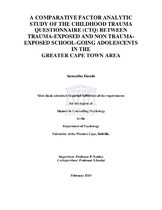| dc.description.abstract | This study investigated the factor analytic structure of the Childhood Trauma Questionnaire(CTQ) in school-going adolescents in the greater Cape Town area. This questionnaire is a retrospective method, assessing childhood exposure to trauma in the form of emotional abuse,physical abuse, sexual abuse, emotional neglect and physical neglect (Bernstein & Fink,1998). The data used originated from a survey where several questionnaires including the Childhood Trauma Questionnaire were used to examine perceived stress and resilience in adolescence. The primary study found that there is extensive published research on trauma exposure in adolescents. However, the investigators found that there is a lack of research on actual perceived stress in the context of certain traumatic experiences. This study examined one of the questionnaires used in the primary study, the CTQ. The question of how the factors cluster in a sample of 631participants between the ages of 11 and 18 was answered by using exploratory factor analysis. Three factor analyses, using principal component analysis and
Varimax rotation with Kaiser Normalisation were run. The three factor analyses are (i) the entire sample (adolescents, both trauma exposed and non trauma–exposed) (ii) the sample with moderate/severe childhood trauma and (iii) the sample with mild/no childhood trauma.The results of the current study revealed that for group one, five rotated factors were yielded that accounted for 59.22% of the variance among items, for group two, eight rotated factors was extracted that accounts for 62.47% of the variance among items and for group three, nine rotated factors which accounted for 65.38% of variance among the items was yielded.After conceptual analysis, it was found that only group two held to the five-factor stucture described in the CTQ's manual. This indicates that the severity of trauma exposure does affect the factor structure of the CTQ in this sample of school-going adolescents. | en_US |

